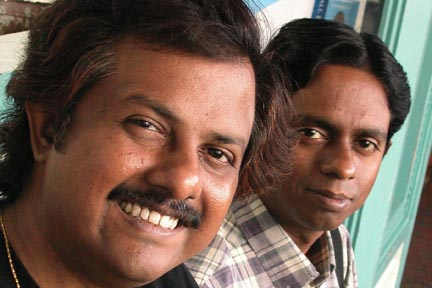
CRAIG T. KOJIMA / CKOJIMA@STARBULLETIN.COM
Many-stringed metaphor
North Indian classical guitarist Debashish Bhattacharya describes himself in poetic terms. As a musician, he sees himself standing in the middle of a collapsing bridge, trying to carry over as much of his steel guitar playing heritage as he can to the other side before the connection is broken forever.
And as for his concert tomorrow night at the Honolulu Academy of Arts, Debashish describes it as "coming full circle."
Debashish Bhattacharya
Where: The Doris Duke Theatre, Honolulu Academy of Arts, 900 S. Beretania St.When: 7:30 p.m. tomorrow
Tickets: $18 general, $15 for students and seniors
Call: 532-8700
"Tau Moe brought the steel guitar to India in 1929, and, 75 years after, I feel really lucky to bring back (to Hawaii) his generation's (music) that has already developed into the rich Indian raga music culture. Tau went with a six-string guitar to Kolkata (then known as Calcutta), and I have brought three instruments which have 24, 14 and four strings to show the development (over) those 75 years and how that six-string guitar has gone through (gradual changes) to find its space in the traditional music of India," Debashish said.
"You can say that Indian raga music is ethnic, but if the ethnicity doesn't have the dynamism to adapt with the times, it dies. There have been so many dead instrumental styles that couldn't come up with today's generation or today's culture. So this 'Trinity of Guitars,' to my belief and my confidence, can really bring a sense of the past. Our kids shouldn't be denied to see their rich past and to bring it to the present and reach forward to the future. That is my goal, and that is why these instruments have been created."
The legacy of Tau Moe's stay in Kolkata provides part of the foundation of Debashish's larger repertoire of both classical and contemporary Indian music. India has its own long-standing tradition of playing string instruments with a slide or bar, and although most musical historians credit Joseph Kekuku with inventing the steel guitar in the late 1880s, Indians point out that Gabriel Davion, who came to Hawaii from India in the 1870s, may well have introduced the slide technique to the islands, even if it didn't become widely known until Kekuku popularized it while attending Kamehameha Schools.
When Moe brought the Hawaiian steel guitar to India, it was embraced by musicians there. Some used it to play Hawaiian music, while others used lap steel techniques in developing new styles of Indian music.
DEBASHISH, who grew up in a musical family and who preferred playing music to school, has since developed his own approach to slide guitar as that aforementioned bridge between Western and Indian classical music.
His self-designed "Trinity of Guitars" consists of:
>> The Chaturangui, a 24-string, hollow-neck Indian classical guitar that blends the tonal resonance of several Indian instruments (including the sitar) while also keeping the original sound of the guitar.Debashish will be playing all three in concert tomorrow night, with his younger brother, Subashish, accompanying on tabla. (Concertgoers will also have the opportunity to buy Debashish's new CD, which is only available in his home country.)>> The Gandharvi, a 12-string that combines the sound of the guitar with Indian classical instruments.
>> The Anandi, a four-string Debashish describes as being similar to a Western slide ukulele, or small lute.
"(The instruments are based on) the Hawaiian steel guitar, but the structure and the tone has been developed in a way that it is the steel guitar plus something ... because if you play a foreign instrument in a foreign culture ... you will always be treated as a guest. That is what I didn't like being a guitarist -- that is why I have tried always to get a form of the slide guitar, which can have the access to the find the tradition of the style and technique of the instrumental technique of my country. That has been the entire focus of my life for the last 30 years."
Debashish adds that he feels personally responsible for ensuring that India's rich cultural heritage isn't pushed aside and forgotten as the pace of globalization quickens. The world has changed more in the past 40 years, he says, than in the previous 400.
He considers the guitar to be the perfect instrument for worldwide musical communication, because it is "an instrument that everybody knows, and its sound is a universal language.
"Hawaiian and Indian guitarists should work together for a new Indo-Oceanic music genre. I'm looking forward to that."
Click for online
calendars and events.

